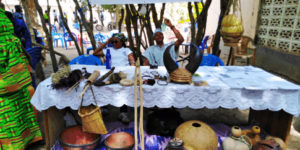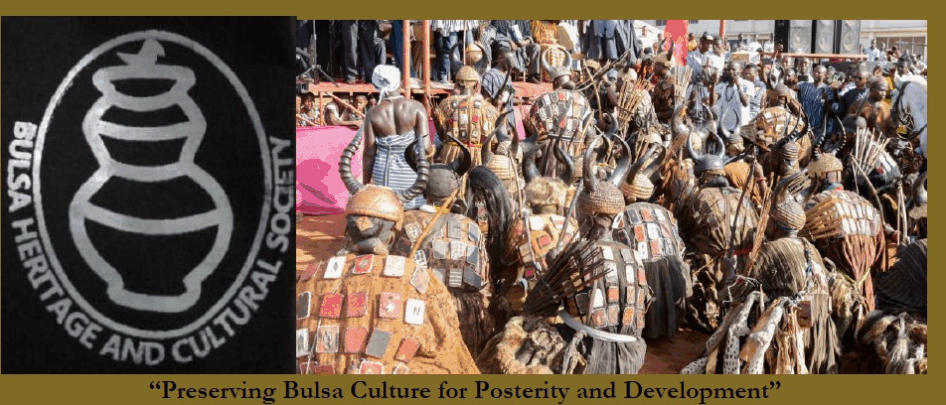
John Akanvariyuei Agandin
Exhibition of Bulsa Material Objects at Feok 2018
“Cultural matters are integral part of the lives we lead. If development can be seen as enhancement of our living standards, then efforts geared to development can hardly ignore the world of culture.” – Amartya Sen
Origins of BHCS
The Bulsa Heritage and Cultural Society (BHCS) is a group of individuals who are enthusiastic about preserving the proud history and culture of the Bulsa people of 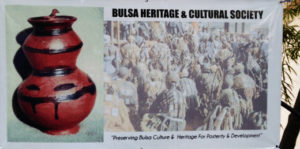 Northern Ghana through the collection, storage and preservation of various specimens of Bulsa material objects, writings, art, and artifacts for present and future generations. The society is borne out of the realization that many Bulsa do not properly understand and appreciate their own culture. Also, the material dimension of the culture is gradually getting lost or being sold to antique collectors at home and abroad. This effectively denies the younger and unborn generations of the substance of their culture; which will affect their being able to take part in, and benefit from their proud heritage and culture.
Northern Ghana through the collection, storage and preservation of various specimens of Bulsa material objects, writings, art, and artifacts for present and future generations. The society is borne out of the realization that many Bulsa do not properly understand and appreciate their own culture. Also, the material dimension of the culture is gradually getting lost or being sold to antique collectors at home and abroad. This effectively denies the younger and unborn generations of the substance of their culture; which will affect their being able to take part in, and benefit from their proud heritage and culture.
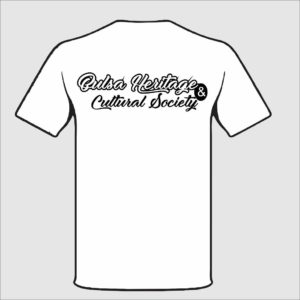
The BHCS believes that the preservation of culture is a way to help the Bulsa to maintain a connection with the unique character of our historic and natural environment, with our language, our music, our arts and our literature, all of which are fundamental to our individual and collective spiritual and physical wellbeing and development.
The BHCS was formed following an appeal made on Facebook on 31st May 2016 by John Agandin. The appeal was inspired by the opening of a Bulsa exhibition in the Werl Museum in Germany on 10th March 2016; a report and photos of which were captured in Buluk, Journal of Bulsa Culture and Society No. 9. The Werl exhibition is the result of the lifelong work of Dr. Franz Kröger among the Bulsa ethnic group.
Plans in the Build up to Feok 2018
In October 2018, the BHCS presented letters of introduction to the Bulsa North District Assembly in Sandema along with a request to display a collection of Bulsa material objects at the district library. The society has already placed a cupboard in the library and is awaiting confirmation from the assembly to place the materials on display. At the same time, the society sent a notice of exhibition to the 2018 Feok Planning Committee to inform them of its intention to hold an exhibition of Bulsa material objects during the celebration of Feok 2018. To our joy and surprise, the Planning Committee not only gladly accepted our notice, but also offered to allocate one of the official tents/sitting areas to the society for the exhibition.
Donations and other Funds
To ensure a successful exhibition, the society embarked on an appeal for funding to procure more materials and to finance the exhibition activities. The appeal was led by Priscilla Animi and was mainly restricted to society members and other interested Bulsa. A couple of members responded positively and a cash amount of two thousand, nine hundred and forty-four Ghana Cedis (GHC 2,944.00) was raised. The amount was spent on acquiring a cupboard to display the materials in the district library, procuring earthenware vessels and other materials by special request, printing t-shirts and a banner, transportation of volunteers and materials to and from the exhibition grounds, refreshments after the event and other activities.
Exhibition at Feok 2018
Due to a slight setback on the day of the festival, the exhibition was staged outside the durbar grounds. A spot was chosen directly beside the main entrance to the grounds for the stand. Being close to the main entrance ensured that as many people as possible moving into or out of the durbar grounds were able to see our banner and exhibition table.
Materials displayed at the exhibition included the following:
1. Pottery: li-toma, cheng, kpalabsa (2), liisa, ma, tibiik, puuk, kpachari, chari
2. Gourds: zaaning and calabashes, gong (big gourd), zom gong, nyiam gona (2),
3. Basketry: busik (cf. Buluk 11, pp. 51-57), yolung/yalung (small basket made of grass)
4. Musical instruments: kayagsa (3)
5. Feok regalia: zuchiak (war-helmet), tom (bow), peema (arrows), namarik (arm quiver), lok (big quiver), jiuk/juiok (fly whisk made of a horse tail)
6. Ornaments: bangsa (bangles), pung/pina (stone bracelets), nifelima, miisa (waist strings), vaata (fibre apron)
7. Journals and books – BULUK, Journal of Bulsa Culture and Society (one copy each of 2013, 2014, 2015, 2016, and 2017 editions),
8. Buli Wamagsima Gela by Peter Wangara
9. Other stories in Buli
10. Articles and other write ups on Bulsa culture and history –
a) “History of The Bulsa With Special Consideration of The Slave Wars” and “Original Myths and History of the Non-Atugabisa” (Extract from Buluk 7, 2013, pp. 79 – 87) by Franz Kröger – 50 copies
b) “Expedition of Lieutenant-Colonel A.H. Morris To Bulsaland” (Extract from the Public Record Office, London)” edited by Franz Kröger – 15 copies
c) “Speaking for The Development of Buli” by George Akanlig-Pare (first published in: BULUK, Journal of Bulsa Culture and Society No. 1 (1999) – 15 copies
d) “The Bulsa Heritage and Cultural Society (BHCS) and the Plan for a Bulsa Cultural Museum” by John Akanvariyuei Agandin (published in Buluk, Journal of Bulsa Culture and Society No. 10 (2017) – 15 copies
e) The Case for A Museum of Bulsa Art, History and Culture (pamphlet published in 2016) by John Akanvariyuei Agandin – 15 copies
f) Unsteady Lines About Bulsaland and Life – collection of 10 unpublished poems by John Akanvariyuei Agandin – 20 copies
g) Photographs of some schools and Pupils in Buluk from 1973 (including, Sandema Middle Boarding School, Ayieta Middle School, Chuchuliga Middle School, Kalijiisa Primary, Siniensi Primary, St. Martins Middle School etc) by Franz Kröger – 10 copies
The society also printed a banner and t-shirts which were worn by all the volunteers throughout the exhibition.
The exhibition table was besieged by both the old and the young, women, and men, and some students to see the materials and ask questions. We have videos and pictures of groups of women playing kayagsa and enacting the process of carrying water and offloading using the liisa (earthen pots). In appreciation, one t-shirt and a copy of the Adventures of Asuom were given out to two players. Many educated Bulsa also visited the exhibition table and gladly accepted free copies of the articles and other write-ups on Bulsa history and life. There was a particularly huge demand for the history of the Bulsa and Non-Atugabisa compiled by Dr Franz Kröger. More than fifty copies were distributed. Indeed, almost all the print outs were taken. Many also showed a keen interest in the copies of the Buluk journal on display and kept asking if they were for sale. Unfortunately, since there was only one copy of each edition, they were not sold and interested persons were only permitted to leaf through them briefly. Whilst the women were happily playing the kayagsa, their male counterparts complained of the absence of musical instruments played by men. When asked what instruments they would like to play, the popular instruments requested were “sinyara (rattles), paampunta (transverse clarinets) and wiisa (flutes)”. Two guys decided to dramatize the process of divination/soothsaying to much curiosity and applause.
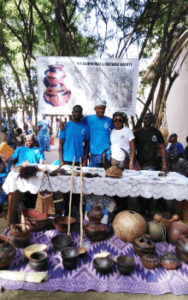
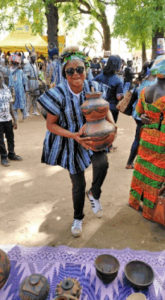
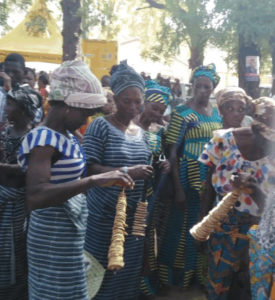
Three women shaking the kayagsa-rattles
Difficulties/Challenges
1. One of the key difficulties we encountered during the exhibition was the absence of members of the society at the Feok celebration. Both Lawrence Abakisi and Cornelius Adumpo were compelled to be away from Sandema during this year’s Feok and David Angaamba was a supporting MC at the durbar. Priscilla Animi came to help but had to spend half the day resting after travelling overnight from Kumasi. I had to rely heavily on three (3) enthusiastic new recruits to run errands, transport materials and keep order at the stand (Daniel Akunyam, Carlven Afelik and Hamidu Amina).
2. The exhibition was nearly derailed on the morning of the Feok durbar due to a miscommunication between the 2018 Feok Planning Committee, the BHCS, and the paramount chief, Nab Azagsuk Azantilow. The chairman of the planning committee claimed that the paramount chief had ‘cancelled’ the exhibition and that he (the chairman), had passed the said information onto some members of the BHCS (namely, Cornelius Adumpo and Lawrence Abakisi) but this was found to be untrue. Due to this misunderstanding, the BHCS was not allocated one of the official tents as was promised. Therefore, the exhibition was held outside the official durbar grounds and hence we lost potential patrons and publicity because the exhibits were not brought to the attention of invited guests and dignitaries at the durbar.
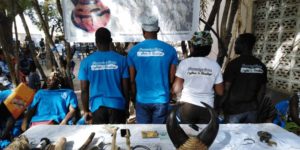
The Way Forward
The society is still working on securing space at the district library to display a couple of our materials for library users particularly school children to view. We have met with the district director of education and he has expressed a high interest and support for this endeavour. We are now awaiting final confirmation from the district assembly.
The opportunity to make monetary contributions towards the purchase of musical instruments is still open. We aim to acquire simple instruments played by men such as sinyaara (rattles), paampunta (side-blown clarinets made from guinea corn stalks), wiisa/yuisa (flutes) and namunsa (side-blown horns).
The BHCS is also interested in holding exhibitions (at least with a few durable and hardy objects) at any Bulsa cultural events anywhere in Ghana. This is in response to the huge interest and curiosity displayed during the two exhibitions held so far in Accra and Sandema in 2018. During these events, it might be possible to usually sell a few interesting materials or raise funds in some other way (e.g. by placing a donations box on our table for visitors to donate what they can afford).
Lawrence Abakisi indicated sometime in late 2018 that he had lobbied for a piece of land near the traditional council where a structure could be built to house the material collection. When this is confirmed, and the land secured, we would need to raise the necessary funds for the building. All members would be required to make a little donation in cash or kind towards this project at the right time.
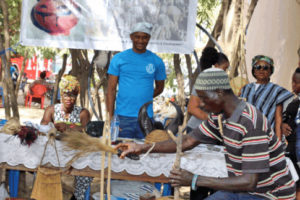
Acknowledgements
The BHCS wishes to thank Daniel Akunyam, Carlven Afelik, Hamidu Amina, Mary Abakisi, Cornelius Adumpo, Priscilla Animi, and John Agandin for their help with the exhibition. We are also grateful to David Angaamba who travelled throughout the two districts and beyond (to Kunkwa) to acquire materials for the exhibition and to Lawrence Abakisi who did a lot of lobbying for us to secure a plot for our museum project. We also appreciate all those who contributed in labour and intellect through suggestions and ideas towards our exhibition and other plans. We thank our donors especially Franz Kröger, Emile Akangoa Adumpo and Richard Andii for their generosity which made the exhibition possible and those who patronized it for their attendance. We thank all the women who came to play kayagsa and the men who dramatized the divination for spicing up our exhibition.
Compiled by:
John Akanvariyuei Agandin; phone: 0246258194
For more information on the Builsa Heritage and Cultural Society, please contact any of the following people.
John Agandin – 0246258194/ agandinjb@gmail.com
Martin Akandawen – 0507176405 – martinakandawen@gmail.com
David Angaamba – 0242776788/ davidangaamba@yahoo.com
Cornelius Adumpo – 0203952142/0246144606/ adagmi@yahoo.com
Priscilla Animi – 0501340250/ animipriscilla1982@yahoo.com
Lawrence Abakisi – 0203510523/ lawbakson@gmail.com
Dr. Franz Kröger (Patron) – Franz_Kroeger@t-online.de
Appendix
Donations Received
Donor/Source Amount (GHC)
Emile Akangoa Adumpo 500
Richard Andii 1,000
Franz Kröger 1,044 (€ 200)
John Agandin 400
Total 2,944
Expenses Before, During and After the Exhibition
Item / Quantity / Number / Costs
Cupboard 1, GHC 1,000
Printing of T-shirts 20, GHC 500
Printing of materials for distribution – GHC 86
Printing of Society Banner, GHC 60
Purchase of Items 40, GHC 850
Token for exhibition table GHC 20
Purchase of exhibition mat GHC 50
Fuel and Transport GHC 200
Water and Refreshments GHC 80
Total GHC 2,846
Balance 2944 – 2846 GHC 98
List of materials/items purchased – number
a. Pottery
i. Li-tomi/li-toma (multibellied vessel) – 2
ii. Liik/liisa (vessel with a narrow mouth) – 2
iii. Samoning/samonsa — Jenta bimbili/bimbilsa (cooking pots) – 2
iv. Ngoari/ngoadi (perforated vessel, steaming pot) – 2
v. Kpachari/kpachaa (trough for chicken’s drinking water) – 2
vi. Ma/ma-bage (knobbed vessel) – 2
vii. Tibiik/tibiisa (vessel for medicine) – 2
viii. Chengsa ni kpalabsa (bowls) – 2
ix. Chari/chaa (big open vessel) – 2
x. Kaam soluk / kasoluk (ash-filter consisting of two vessels)– 1
xi. Tachengsa (tobacco pipe) – 2
xii. Puuk (lidded vessel) – 1
b. Others
i. Gong (big calabash, e.g. for fetching water) – 1
ii. Zom gong (calabash for millet flour)– 1
iii. Nyiem gona or leng (bottle-shaped calabash for water)– 2
iv. Gori gong (closed calabash that may be used for making gori-drums) – 1
v. Piema (arrows)– 3
vi. Kayagsa (type of rattle)– 2
vii. Tulik (carrying pad)– 1
viii. Pung/Pina (here: stone armlets) – 2
ix. Nanzuk niri (lower grindstone of a grinding-room)– 1
x. Gbaluk (spear/javelin) – 1
Note: Because of the delicate nature of the pottery items, not all of them were taken to the exhibition.
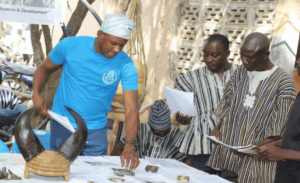
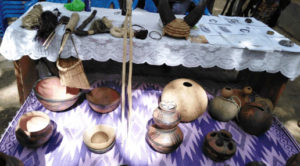
- Contents of BULUK 12
- Editorial
- Events
- Who on Earth is interested in the Bulsa?
- Discussions in the Facebook Group “BULUK KANIAK”
- New Published and Unpublished Studies on Bulsa Culture
- The Sights, Sounds and Glitter of Feok 2018
- Report on BHCS Exhibition of Bulsa Material Objects at Feok 2018 in Sandema
- Bulsa Pomp and Pageantry
- John A. Agandin: Two Poems
- The Medical System of the Bulsa
- List of Plants for Medicine and Other Purposes
- Dental Health – the next lifestyle disease?
- Free surgical procedures by Dr. Benjamin Akinkang’s Team of Hope
- Ambulance not on the Road: A Disgrace to Health Care for Buluk
- Management of Perceived Malaria Infections in Children among Bulsa Mothers
